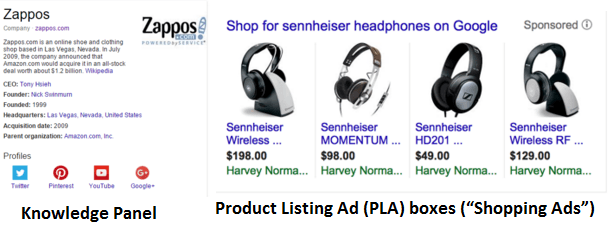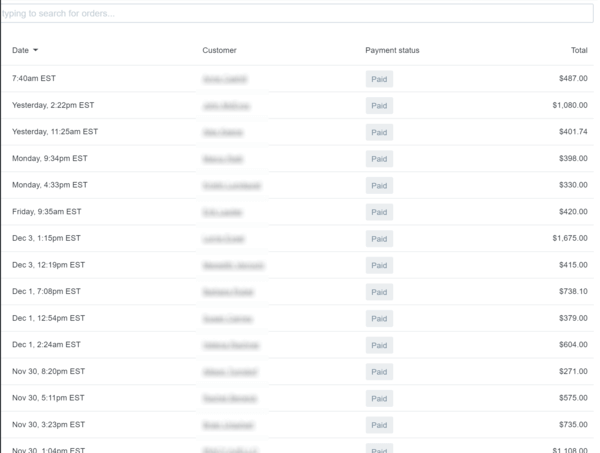We’ve all heard it before, “AdWords isn’t for small businesses”. Fortunately, that is a myth. In today’s post we’d like to help you understand that AdWords for eCommerce businesses is an ideal and vital tool to create a base for sustainable growth.
The goal of the post is to show you that AdWords has the ability to empower your eCommerce business, and at the same time to let you know that like many good things, there are challenges that will stand in your way to optimizing AdWords.
Finally, we’ll also let you in on our attempt to turn AdWords into an accessible channel for eCommerce businesses – both small and large.
Why AdWords for eCommerce Businesses is a Must
Google’s Function as a Search Engine
The best reason to advertise on Google is quite simply due to the fact that people from all over the world are using Google for the exact same reason: to find stuff. There is a difference in the mindset of someone sharing images and someone looking for new shoes.
Although other ad platforms have been gaining popularity as a viable and high converting ad platform, Google still leads the way as the the gateway consumers are using to get information on products and then making purchases. This is the place to catch potential customers when they are actively searching to buy what you have to offer!
AdWords Offers an Extremely High Level of Accuracy
Google knows everything. As a business owner or digital marketer, that is something you must leverage. As they say, “Knowledge is power”. Advertising on Google AdWords enables you to reach the exact target audience, at the ideal time and location.
In Google’s ad scheduling, every business can have their ads displayed to customers’ at the optimal time (days and hours), location, based on their zip code, or target people based on more specific data, such as interest, age, gender, parental status and income level. These are options that only give you more control over your ads and need to be leveraged to increase the ROI on your ad spend.
AdWords Ads Place You Near Competitors
When using AdWords, your ads are displayed not only side by side (above, below, or to the side) of organic search results, but also directly next to your competitors’ ads. This can be both good and bad, but we’ll focus on the pros. Assuming you’ve got a great unique selling proposition, great customer reviews, and some catchy text then being placed next to competitors is a great move.
The competitive ad display enables your business to show itself off in comparison to other options, unlike other ad platforms that place your advertisement on its own (both styles have benefits). Think of Google AdWords as a shopping mall. Are you more hyped to buy new stuff when there is just one store or when you are in a shopping mall? I for one prefer the shopping mall.
Fierce eCommerce Competition
The eCommerce market is continually growing and shows no signs of slowing down in the near future. The following data from Statista shows the global retail eCommerce sales volume, past and future (expected) through 2018. More sellers and more purchases by consumers may turn eCommerce into one of the leading professional industries in 2020 and beyond.
Find more statistics at Statista
Said competition means one thing: standing out will be challenging. Getting organic visits from Google will get more interesting. Getting a hold on successful AdWords practices now can help you grow now and fend off competitors in the future.
Shopping Retargeting Lists
On average, 98% of web stores’ visitors end their visit without making a purchase. 70% of them will never go back to that web store.
This is where Google’s Remarketing capabilities offer irreplaceable advantages for the web store owner. Instead of giving up on those 98% that the merchant worked hard to drive into his/her web store, the merchant gets a second chance (and third, and fourth, etc.) to drive those visitors back. The web store can now show the returning visitor the original products they were after, or similar products, luring them back in with the best promotion for those products.
The Challenges of AdWords for eCommerce
AdWords has the benefits that can make your eyes water with joy. That is not a joke, and hundreds of thousands of businesses around the globe spend hundreds, if not thousands, advertising on Google each day. However, for all of the pros that come with the platform, there are a couple drawbacks.
Paying for Clicks
The problem with paying for clicks is two-fold. The first, and most obvious, problem is that a click does not necessarily mean a sale. Hence you could find yourself getting plenty of clicks, yet not enough sales, so that the cost of acquiring a customer holds a higher value than the average purchase.
It is not enough to bid on the right keywords, you have to avoid some keywords using Negative Keywords, and you have to match your keywords to the most relevant ads and landing page that will all together generate the best flow for the user (which in turn rewards you with a lower cost per click required by Google AdWords).
Rising Costs of Clicks
The second problem is the rising cost of clicks. As more and more businesses have flocked to AdWords the cost of a click has steadily risen. Today, you can find keywords that cost $60 per click! How has this happened? This is a result from businesses not understanding the concept of order value needing to be greater than ad spend (per customer), which leads to businesses erroneously spending. Another cause is due to bigger, stable businesses that have a consistent cash flow to spend on advertising. They’re not spending dollars or even three-digit sums. They have the capability to spend much more, and so when a new or small business launches its first campaign, all of the relevant keywords have been taken. The result – higher prices.
AdWords Takes Time to Learn and Use
If you were to run a Google search for tips to succeed with AdWords you’d probably find enough to read to take up an entire month. Succeeding at AdWords (i.e. convertible ads and lower cost per acquisition of a new customer than the amount a new customer spends) takes frequent logins (keeping a constant eye on campaigns), adding new keywords, adding negative keywords, setting up campaigns for micro conversions, the right keyword matches, implementing ad extensions,
AdWords in 2016
As you may have heard, Google will be making some changes to the form in which ads are displayed, with almost all ads that appear to the side of search engine results being removed.
According to Search Engine Land, only two type of ads will still be displayed next to the natural results (and not just above or below them): (1) Product Listing Ad (PLA) boxes (also known as “Shopping Ads”), and (2) ads in the knowledge panel.

What does this mean for your business?
Regarding the regular ads, this simply means that the competition on AdWords will be stiffer. With fewer positions in regular AdWords results, yet a growing number of advertisers there could be a slight jump in the cost of all keywords (demand is exceeding supply).
Those using PLA boxes will probably see an increase in competition as well, as advertisers seek new opportunities to get their products in front of consumers.
The Small Business AdWords Solution: Traffic Booster
What is Traffic Booster?
Traffic Booster is an eCommerce app that we have created in order to automate traffic generation to web stores. Instead of an eCommerce business either hiring someone to focus on creating ads for them or taking valuable time to learn how to optimize results, the eCommerce professional simply tells us what category their products are part of, what pages should act as ‘landing pages’, and pick the target audience. We then do the rest of the work.
We have developed an algorithm for targeting shoppers per industry and store, which enables us to get the best value for money that no one single store can gain on its own.
The algorithm includes the following capabilities:
1. Automatic bid optimizer – real time bidding that finds the most cost effective bid for your campaigns at any given time.
2. Dynamic keywords & ads – real time adjustments of the keywords, ads and the most relevant category or product page at your store to the search queries seek on Google.
3. Learning machine – constantly use the most suitable advertising method for each store.
What makes this any different than hiring a PPC expert? Aside from the cost differences (our smallest plan starts at $49.99 and the biggest plan start at $499.99, plus you get 33% off on your first month), the team developing and managing the ads and the algorithm has experience managing more than $100 million worth of ad spending on AdWords, Facebook, and other ad platforms. The algorithm’s real time optimization capabilities cannot be matched by a PPC human expert or even by a department of experts.
For more on how Traffic Booster works, take a look >> Better eCommerce Customer Acquisition: The Traffic Booster and its ‘Secret Sauce’.
Why do you need Traffic Booster?
The answer is simple: ROI. Advertising on Google AdWords should no longer be a questions of whether it can benefit you (if that was a question before reading this post). Knowing that it can be a vital channel for business growth, the question then becomes how you’ll get the best results.
For a relatively new product (less than 6 months on the market) that is still going through constant optimizations and improvements, we’ve already successfully generated a positive ROI for more than 85% of the campaigns we’ve ran. For jewelry retailer Nava Zahavi we were able to generate $30 thousand in sales in one month.

The eCommerce website Running On The Wall earned a 450% ROI over a period of 45 days with Traffic Booster (for every $1 spent on Traffic Booster, we were able to deliver $4.50 in sales).
That’s All Folks
Google AdWords (for all the success Facebook has brought advertisers) is the best channel on the web to advertise your business – if you optimize your ads to get clicks from your ideal target market. We’d love to know if you are using AdWords, and if so, how has your experience been. What have been the biggest challenges? Have you been surprised – good or bad – by the process?
If you’ve got any questions regarding Traffic Booster, feel free to reach out to our team. Get Traffic Booster now or get in touch with us with any questions you may have.

Ty is a digital marketing enthusiast that can't get enough social media marketing and content marketing. He is the inbound marketing manager at StoreYa where he spends his days searching for the newest social marketing scoop and creating amazingly awesome content. If you’d like to chat with him, feel free to connect with him on any social platform.
Recommended articles
 Facebook Ads for eCommerce: 16 Strategies, Examples & Tips
Facebook Ads for eCommerce: 16 Strategies, Examples & Tips
 How to Build a Winning eCommerce Ads Strategy
How to Build a Winning eCommerce Ads Strategy
 Google Ads for eCommerce: Everything You Need to Know
Google Ads for eCommerce: Everything You Need to Know
 10X Your Traffic with PPC Management Software
10X Your Traffic with PPC Management Software
Comments
Powered by Facebook Comments



